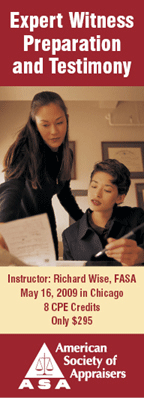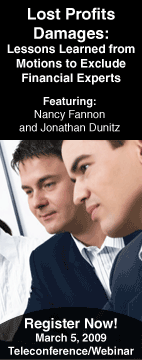
| Kentucky joins majority in distinguishing enterprise vs. personal goodwill—and includes interesting ruling on non-competes, too In Gaskill v. Robbins (Feb. 19, 2009), the wife was a well-established oral surgeon in Bowling Green, Kentucky, with her own solo practice and staff. At her divorce trial, the wife’s CPA compiled a “detailed” report using an asset-based approach that valued the practice at just over $220,000. The husband’s expert used the same data in applying four different approaches (capitalized and excess earnings, adjusted balance sheet, and market). Finding all reliable but none determinative, he averaged the four values to assess the practice at nearly $670,000, which assumed goodwill as well as a non-compete. The trial court adopted this value and the wife appealed. The Kentucky Court of Appeals sought a discretionary review by the Kentucky Supreme Court, which noted the contention that has surrounded the question “for many years.” The top Kentucky court conducted a thorough analysis—including 5 key questions that a willing buyer would ask in arriving at a fair market price for a professional practice (e.g., what can be earned from this business over a reasonable time? What is the value of the personnel who will remain?) It also referenced two leading decisions that helped establish the now-majority rule, May v. May, (W.Va. 2003) and Yoon v. Yoon, (Ind. 1999.) After noting their “compelling” reasoning, the court held that the “distinction between enterprise and personal goodwill has a rational basis that accepts the reality of specific business situations.” A note on non-competes. The court also (gently) chastised the trial court for accepting a valuation that was based simply on averaging four approaches. “Employing all four methods, then averaging them, is tantamount to no method at all,” the court said. In addition, the expert erred in assuming that a “non-existent” non-compete would be part of a hypothetical, fair market value sale. “The fictional sale should be viewed as a ‘fire sale,’” the court said, “meaning that it must be valued in its existing state.” A full write-up of this case will appear in the April Business Valuation Update newsletter—subscribe here. Why BV experts cannot afford to overlook guideline public company research According to Robert Schlegel, a principal with Houlihan Valuation Advisors, “Public company trades are the best fundamental barometers of general market conditions that we have. Valuation implies an appraisal opinion at a date in time that reflects, as IRS Revenue Ruling 59-60 points out, 'the economic outlook in general and the condition and outlook of the specific industry in particular.' Common standards of Fair Market Value and Fair Value (for financial reporting) imply our examination of market transactions and intentions of market participants. Therefore, an appraisal that ignores market evidence really is not an appraisal.” Indeed, experts agree that no tool in business valuation more accurately captures current economic conditions or volatility as the Guideline Public Company Method (GPCM), and there has never been a better opportunity—or need—to develop a complete understanding of this increasingly essential valuation method. With this in mind, on March 26 and 27 at the Deauville Beach Resort in Miami, Florida, BVR will host an intensive day-and-a-half workshop on the GPCM, hosted by Schlegel. Attendees will develop a complete understanding of the GPCM and its effective application in all aspects of business valuation. Twelve CPE credits are available to attendees. To find out more about guideline public company research, check out this week’s free download, Wrestling with Guideline Public Market Evidence: What You Need to Know, now available at BVResources. To hear a podcast interview with Rob about the session and to register for this very important event, click here BVWire™ readers sound off on the Pomeroy Bill and its possible impact on the profession Last week’s issue included an excerpt from a Letter to the Editor that took exception to the position offered by William Frazier, vice-chairman of the American Society of Appraisers’ Government Relations Committee, on “the Pomeroy Bill,” also known as the Certain Estate Tax Relief Act of 2009, H.R. 436. Among other things, Frazier’s contention—published here and in the March Business Valuation Update—is that the bill could bring about the demise of the valuation of fractional interests in family owned investment entities. The letter-writer disagreed and cautioned that one “should not assume all readers agree… If its bad policy, we cannot endorse it just because some of us make money executing that poor policy.” Not surprisingly, we received a number of responses to this letter, one of which—from attorney Owen Fiore, an Idaho-based family wealth-planning consultant—we offer below:
Another take on Fair Value: Does the FAS 157 emperor have no clothes? “User Views On Fair Value: Vinny Catalano, CFA, Randy Schostag, CFA,” is a recent interview conducted by Edith Orenstein, director of Accounting Policy Analysis with Financial Executives International, that yielded comments and insights that may sound familiar to BV experts who follow the views offered by Aswath Damodaran, Professor of Finance at the Stern School of Business at New York University. When asked if he believed Fair Value should be modified and, if so, how, Schostag offered this response:
The complete interview—“conducted prior to the Financial Accounting Standards Board’s Feb. 18, 2009 announcement that it will embark on a short-term project to improve the ‘application guidance’ for determining fair value in inactive markets and fair value disclosures”—is a definite must-read. The International Valuation Standards Council (IVSC) continues buildup toward global standards for the valuation process Yesterday, the IVSC announced that Michel Prada, former chair of the Autorité des Marchés Financiers in Paris, will chair its restructured International Valuation Standards Council. Also on the IVSC Board are: Patrick Gounelle, former global managing partner at Ernst & Young and vice chairman of the Board of Trustees of the IVSC; Nicholas Brooke, chairman of Professional Property Services Limited in Hong Kong; Roel Campos, partner in charge of the Washington, D.C. office of law firm Cooley Godward Kronish, and former Commissioner of the US Securities and Exchange Commission; Brad Dalgliesh, recently retired as senior partner of KPMG’s Canadian Valuation Services Practice and currently senior counsel to the firm; Lee Hackett, executive vice-president, global operations with American Appraisal Associates Inc.; and Madame Liu, Secretary General of the China Appraisal Society.
An interesting (and free) take on the valuation of biotech companies We recently stumbled upon the article, The Art & Science of Valuation in the Biotechnology Marketplace, authored by biotechnology analyst Viren Konde. Although at first glance, Konde’s overview of valuation approaches seems somewhat basic, we highly recommend that analysts with an interest in the biotech area take the time to read the article.
|
Copyright © 2009 by Business Valuation Resources, LLC
BVWire™ (ISSN 1933-9364) is published weekly by Business Valuation Resources, LLC
Editorial Staff | Advertise in the BVWire | Copyright Notice
|
|


